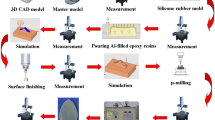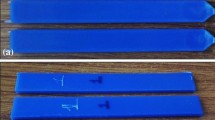Abstract
This Prospective covers an overview of the injection molding process and the importance of mold design and tooling considerations, important material requirements and thermal properties for molds, polymer material requirements for injection molding, mold flow analysis, and the promise of using the 3D printing process for mold fabrication. The second part demonstrates the injection molding process using 3D-printed polymer molds and its suitability for low-run productions. 3D-printed molds using stereolithography and fused filament fabrication have been injected with polylactic acid, and the quality of the injected parts was assessed in terms of dimensional accuracy and the damage mechanisms during fabrication.











Similar content being viewed by others
References
Stratasys: https://www.stratasysdirect.com/manufacturing-services/subtractive-manufacturing/3d-printing-expands-traditional-manufacturing (accessed April 2019).
Jaycon Systems: https://medium.com/jaycon-systems/why-is-injection-molding-so-expensive-eda69b6fccb5
P.A. Kobryn, N.R. Ontko, L.P. Perkins, and J.S. Tiley: Additive Manufacturing of Aerospace Alloys for Aircraft Structures. Air Force Research Lab Wright-Patterson AFB OH Materials and Manufacturing Directorate, 2006.
V.T. Le, H. Paris, and G. Mandil: Process planning for combined additive and subtractive manufacturing technologies in a remanufacturing context. J. Manuf. Syst. 44, 243 (2017).
J.R.C. Dizon, A.H. Espera, Q. Chen, and R. Advincula: Mechanical characterization of 3D-printed polymers. Addit. Manuf. 20, 44 (2018).
Stratasys, 3D Printing and Dental Implants: http://www.stratasys.com/resources/white-papers/3d-printing-and-dental-implants (accessed June 2017).
Formlabs: https://3d.formlabs.com/injection-molding/ (accessed May 2019).
D.V. Rosato and M.G. Rosato: Injection Molding Handbook, 3rd ed. 23 (Springer Science+Business Media, New York, 2000).
Engineers Edge: https://www.engineersedge.com/manufacturing/injec-tion-molding-review.htm (accessed April 2019).
R.M. Khan and G. Acharya: Plastic injection molding process and its aspects for quality: a review. Eur. J. Adv. Eng. Technol. 3, 66–70 (2016).
W.G. Frizelle: Injection molding technology. In Applied Plastics Engineering Handbook, 2nd ed. Processing, Materials, and Applications, Plastics Design Library, edited by Myer Kutz (William Andrew/Elsevier, Norwich, NY, 2017) pp. 191–202.
S.J.A. Rizvi: Effect of injection molding parameters on crystallinity and mechanical properties of isotactic polypropylene. Int. J. Plast. Technol. 21, 404–426 (2017).
T. Rogers: Everything you need to know about injection molding. https://www.creativemechanisms.com/blog/everything-you-need-to-know-about-injection-molding (accessed April 2019).
Engineers Edge: https://www.engineersedge.com/manufacturing/injection-molding-applications.htm (accessed April 2019).
P.K. Johnson: Metal injection molding trends report. Int. J. Powder Metall. 55, 11 (2019).
J. Greener and R. Weimberg-Freidl: Injection molding for microfluidics applications. Precision Inject. Mold 169, 169–175 (1990).
A.C. Liou and R.H. Chen: Injection molding of polymer micro- and sub-micron structures with high-aspect ratios. Int. J. Adv. Manuf. Technol. 28, 1097 (2006).
3D Systems: https://www.3dsystems.com/quickparts/learning-center/ injection-molding-basics (accessed April 2019).
A.R. Agrawal, I.O. Pandelidis, and M. Pecht: Injection molding process control: a review. Polym. Eng. Sci. 27, 1 (1987).
R.A. Malloy: Prototyping and Experimental Stress Analysis, Plastic Part Design for Injection Molding: An Introduction (Hanser Publishers, Munich; New York; Cincinnati, 1994).
H. S. Park and X.-P. Dang: Technology for improving productivity and quality of injection molding. In DAAAM International Scientific Book, edited by Branko Katalinik (DAAAM International Publishing, DAAAM International Vienna DAAAM scriptorium GmbH, 2018), pp. 185–194.
E. Sachs, E. Wylonis, S. Allen, M. Cima, and H. Guo: Production of injection molding tooling with conformal cooling channels using the three dimensional printing process. Polym. Eng. Sci. 40, 1232 (2000).
K.M.B. Jansen, D.J. Van Dijk, and M.H. Husselman: Effect of processing conditions on shrinkage in injection molding. Polym. Eng. Sci. 38, 838 (1998).
K.M.B. Jansen and G. Titomanlio: Effect of pressure history on shrinkage and residual stresses: injection molding with constrained shrinkage. Polym. Eng. Sci. 36, 2029 (1996).
General Electric: http://plasticwright.com/files/8314/0476/4159/GE_plastic_design.pdf (accessed May 2019).
A. B. Varotsis: https://www.3dhubs.com/knowledge-base/injection-molding-manufacturing-technology-explained%0D
T. Tremblay: Injection Molding Part Design for Dummies (Proto Labs, John Wiley & Sons, New York, 2012).
D. O. Kazmer: Injection Mold Design Engineering (Hanser, Munich, 2007).
A. Adhikari, T. Bourgade, and A. Asundi: Residual stress measurement for injection molded components. Theor. Appl. Mech. Lett. 6, 152 (2016).
B.K. Kim and J.W. Min: Residual stress distributions and their influence onpost-manufacturing deformation of injection-molded plastic parts. J. Mater. Process. Technol. 245, 215 (2017).
A. Guevara-Morales and U. Figueroa-Lopez: Residual stresses in injection molded products. J. Mater. Sci. 49, 4399 (2014).
B.H. Lee and B.H. Kim: Variation of part wall thicknesses to reduce warp-age of injection-molded part: robust design against process variability. Polym. Plast. Technol. Eng. 36, 791 (1997).
E. C. Bernhadt: CAE-Computer Aided Engineering for Injection Molding (Hanser Publishers, Munich; New York: Cincinnati, 1983).
D. Masato, J. Rathore, M. Sorgato, S. Carmignato, and G. Lucchetta: Analysis of the shrinkage of injection-molded fiber-reinforced thin-wall parts. Mater. Des. 132, 496 (2017).
S. Hazenbosch: How to design parts for injection molding. https://www.3dhubs.com/knowledge-base/how-design-parts-injection-molding.
I. Pandelidis and Q. Zou: Optimization of injection molding design. Part I: gate location optimization. Polym. Eng. Sci 30, 873–882 (1990).
R. Kerstra: TOOLING: how to select the right tool steel for mold cavities. Plastics Technol (2016). https://www.ptonline.com/articles/tooling-how-to-select-the-right-tool-steel-for-mold-cavities.
Kaysun Corporation: https://www.ecnmag.com/article/2013/05/mold-design-tooling-injection-molding.
Jaycon Systems: https://medium.com/jaycon-systems/injection-mold-tooling-materials-aluminum-vs-steel-7b5f64ee1112 (accessed May 2019).
A. Hamasaiid: https://www.moldmakingtechnology.com/articles/making-the-right-mold-material-selection-for-thermal-management-of-molds-and-inserts (accessed May 2019).
Misumi: https://www.misumi-techcentral.com/tt/en/mold/2011/08/091-thermal-expansion-of-molds.html (accessed May 2019).
S.M. Shelton: Thermal conductivity of some irons and steels over the temperature range of 100 to 500C. Part Bur. Stand. J. Res. 12, 441–450 (1934).
W.D. Callister Jr.: Materials Science and Engineering: An Introduction, 7th ed. (John Wiley & Sons, Inc., New York, NY, 2007).
V. Goodship, B. Middleton, and R. Cherrington: Design and manufacture of plastic components for multifunctionality. In Structural Composites, Injection Molding, and 3D Printing, Chapter 4: Injection Molding of Thermoplastics, 1st ed. (William Andrew/Elsevier, Norwich, NY, 2015) pp. 103–170.
Stratasys: Demonstration of an Effective Design Validation Tool for 3D Printed Injection Molds (3DPIM): https://www.google.com/url?sa=t&rct=j&q=&esrc=s&source=web&cd=1&ved=2ahUKEwiqmOKvxpziAhVQ GKYKHeUaAXAQFjAAegQICBAC&url=https://%3A%2F%2Fwww.stratasys. co.jp%2F-%2Fmedia%2Ffiles%2Fwhite-papers-new%2Fwp_pj_effective designvalidation_0417a-web.pdf&usg=AOvVaw2GqbovdMtGljW33D5ytDYG (accessed May 2019).
ASTM F2792: Standard terminology for additive manufacturing technologies (No. F2792-12a). ASTM Int. 2–4 (2013). doi:10.1520/ F2792-12A.2.
P.C. Sai and S. Yeole: Fused deposition modeling: insights. Int. Conf. Adv. Des. Manuf. 1345–1350 (2014).
A.C. De Leon, Q. Chen, N.B. Palaganas, J.O. Palaganas, J. Manapat, and R.C. Advincula: High performance polymer nanocomposites for additive manufacturing applications. React. Funct. Polym. 103, 141 (2016).
J.R.C. Dizon, Q. Chen, A.D. Valino, and R.C. Advincula: Thermo-mechanical and swelling properties of three-dimensional-printed poly (ethylene glycol) diacrylate/silica nanocomposites. MRS Commun. 9, 209–217 (2019).
D. Afonso, L. Pires, R.A. de Sousa, and R. Torcato: Direct rapid tooling for polymer processing using sheet metal tools. Proc. Manuf. 13, 102–108 (2017).
A. Rosochowski, and A. Matuszak: Rapid tooling: the state of the art. J. Mater. Process Technol. 106, 191–198 (2000).
S. Jayanthi, B. Bokuf, R. Mcconnell, R.J. Speer, and P.S. Fussell: Stereolithographic injection molds for direct tooling. In Solid Freeform Symposium (The University of Texas at Austin, Texas Scholar Works, University of Texas Libraries, Austin, TX, 1997) pp. 275–286.
Y.M. Chen and J.J. Liu: Cost-effective design for injection molding. Robot. CIM-Int. Manuf. 15, 1–21 (1999).
H.S. Wang, Y.N. Wang, and Y.C. Wang: Cost estimation of plastic injection molding parts through integration of PSO and BP neural network. Expert Syst. Appl. 40, 418–428 (2013).
D.V. Rosato and M.G. Rosato: Injection Molding Handbook (Springer Science & Business Media, Berlin/Heidelberg, Germany, 2012).
P. Dewhurst and G. Boothroyd: Early cost estimating in product design. J. Manuf. Syst. 7, 183–191 (1988).
D. Snelling, Q. Li, N. Meisel, C.B. Williams, R.C. Batra, and A.P. Druschitz: Lightweight metal cellular structures fabricated via 3D printing of sand cast molds. Adv. Eng. Mater. 17, 923–932 (2015).
D. Bak: Rapid prototyping or rapid production? 3D printing processes move industry towards the latter. Assembly Autom. 23, 340–345 (2003).
J. Chimento, M.J. Jason Highsmith, and N. Crane: 3D printed tooling for thermoforming of medical devices. Rapid Prototyp. J. 17, 387–392 (2011).
Y. Hwang, O.H. Paydar, and R.N. Candler: 3D printed molds for non-planar PDMS microfluidic channels. Sensors Actuat. A: Phys. 226, 137–142 (2015).
M.A. León-Cabezas, A. Martínez-García, and F.J. Varela-Gandía: Innovative advances in additive manufactured moulds for short plastic injection series. Proc. Manuf. 13, 732–737 (2017).
S. Ma, I. Gibson, G. Balaji, and Q.J. Hu: Development of epoxy matrix composites for rapid tooling applications. J. Mater. Process. Technol. 192–193, 7–82 (2007).
S. Rahmati and P. Dickens: Rapid tooling analysis of Stereolithography injection mould tooling. Int. J. Mach. Tools Manuf. 47, 740–747 (2007).
B. Redwood: http:www.3dhubs.com/knowledge-base/3d-printing-low-run-injection-molds.
E. Vojnová: The benefits of a conforming cooling systems the molds in injection moulding process. Proc. Eng. 149, 53–543 (2016).
K-.H. Chang: Chapter 15-product cost estimating.In e-Design, edited by K.-H. Chang (Academic Press, Boston, MA, 2015), pp. 787–844.
J. Noble, K. Walczak, and D. Dornfeld: Rapid tooling injection molded prototypes: a case study in artificial photosynthesis technology. Proc. CIRP 14, 251–256 (2014).
Trinseo: http://www.trinseo.com/Products/Plastics/Products/Polystyrene/STYRON (accessed May 2019).
Plexiglas: https://www.plexiglas.com/en/media/news/news/Arkemas-Altuglas-International-business-achieves-new-levels-of-heat-resistance-with-Plexiglas-HT121-acrylic-resin/ (accessed May 2019).
Sabic: https://www.sabic.com (accessed May 2019).
Victrex: https://www.victrex.com/∼/media/datasheets/victrex_tds_450g. pdf (accessed May 2019).
A.A. Dzulkipli and M. Azuddin: Study of the effects of injection molding parameter on weld line formation. Proc. Eng. 184, 663–672 (2017).
W. Guo, H. Mao, B. Li, and X. Guo: Influence of processing parameters on molding process in microcellular injection molding. Proc. Eng. 81, 670–675 (2014).
M.D. Azaman, S.M. Sapuan, S. Sulaiman, E.S. Zainudin, and A. Khalina: Shrinkages and warpage in the processability of wood-filled polypropylene composite thin-walled parts formed by injection molding. Mater. Des. 52, 1018–1026 (2013).
Matweb: Nylene PA6/6 Glass Filled 5113 HS Nylon 6/6 http://www.mat-web.com/.
Covestro: Covestro Resins https://solutions.covestro.com.
S.H. Tang, Y.J. Tan, S.M. Sapuan, S. Sulaiman, N. Ismail, and R. Samin: The use of Taguchi method in the design of plastic injection mould for reducing warpage. J. Mater. Process. Technol. 182, 418–426 (2007).
V. R. Sastri: Commodity thermoplastics. In Plastics in Medical Devices (William Andrew/Elsevier, Norwich, NY, 2010) pp. 73–119.
V. R. Sastri: Materials used in medical devices. In Plastics in Medical Devices (William Andrew/Elsevier, Norwich, NY, 2014) pp. 19–31.
H. Maddah: Polypropylene as a promising plastic: a review. Am. J. Polym. Sci. 6, 1–11 (2016). doi: 10.5923/j.ajps.20160601.01.
A. Pye: High performance engineering plastics. Mater. Des. 3, 407–409 (1982).
N.D. Polychronopoulos and J. Vlachopoulos: Functional Polymers. Acta Mater. 48, 253–262 (2019).
D. S. John Vlachopoulos: The role of rheology in polymer extrusion, 2003. https://www.researchgate.net/publication/266472193_The_Role_of_Rheology_in_Polymer_Extrusion.
S. Imihezri, S. Shaharuddin, and M.S. Salit: A review of the effect of moulding parameters on the performance. Turk. J. Eng. Environ. Sci. 30, 23–34 (2006).
S.A. Jahan, T. Wu, Y. Zhang, H. El-Mounayri, A. Tovar, J. Zhang, D. Acheson, R. Nalim, X. Guo, and W.H. Lee: Implementation of conformal cooling & topology optimization in 3D printed stainless steel porous structure injection molds. Proc. Manuf. 5, 901–915 (2016).
H. Hassan, N. Regnier, C. Le Bot, and G. Defaye: 3D study of cooling system effect on the heat transfer during polymer injection molding. Int. J. Therm. Sci. 49, 161–169 (2010).
B. Ozcelik, E. Kuram, and M.M. Topal: Investigation the effects of obstacle geometries and injection molding parameters on weld line strength using experimental and finite element methods in plastic injection molding. Int. Commun. Heat Mass Transf. 39, 275–281 (2012).
J. Bralla: Design for Manufacturability Handbook (McGraw-Hill Handbooks), 2nd ed (McGraw-Hill Education, New York, 1998).
Stack Exchange: https://3dprinting.stackexchange.com/questions/1083/ layer-delamination
LyondellBasell: https://www.lyondellbasell.com/en/products-technology/ polymers/process-type/injection-molding/ (accessed May 2019).
G. Singh and A. Verma: A brief review on injection moulding manufacturing process. Mater. Today Proc. 4, 1423–1433 (2017).
Z. Chen and L.S. Turng: A review of current developments in process and quality control for injection molding. Adv. Polym. Techn. 24, 16–182 (2005). https://doi.org/10.1002/adv.20046.
Y. Amer, M. Moayyedian, Z. Hajiabolhasani, and L. Moayyedian: Reducing warpage in injection moulding processes using Taguchi Method Approach: ANOVA. In Proceedings of the IASTED International Conference on Engineering and Applied Science (EAS) (International Association of Science and Technology for Development, Colombo, Sri Lanka, 2012). doi:10.2316/P.2012.785-089.
S.H. Tang, Y.M. Kong, S.M. Sapuan, R. Samin, and S. Sulaiman: Design and thermal analysis of plastic injection mould. J. Mater. Process. Technol. 171, 259–267 (2006).
Samson Teklehaimanot, Simulation and Design of a plastic injection Mold: A Joint mold for credit card and USB holder: https://www.the-seus.fi/bitstream/handle/10024/41114/Samson%20Teklehaimanot%20 Final%20Thesis.pdf
Javelin: http:www.javelin-tech.com/3d/manufacture/molds.
H. Watkin: https://all3dp.com/fraunhofer-ipa-combine-3d-printing-injection-molding-advantages/
Z. Quan, A. Wu, M. Keefe, X. Qin, J. Yu, J. Suhr, J.H. Byun, B.S. Kim, and T.W. Chou: Additive manufacturing of multi-directional preforms for composites:opportunities and challenges. Mater. Today 18, 503–512 (2015).
A. H. Espera, J. R. C. Dizon, Q. Chen, and R. C. Advincula: 3D-printing and advanced manufacturing for electronics. Prog. Addit. Manuf 4, 245–267 (2019).
Q. Chen, J. D. Mangadlao, J. Wallat, A. De Leon, J.K. Pokorski, and R.C. Advincula: 3D printing biocompatible polyurethane/poly(lactic acid)/gra-phene oxide nanocomposites: anisotropic properties. ACS Appl. Mater. Interfaces 9, 401–4023 (2016). https://doi.org/10.1021/acsami.6b11793.
Acknowledgments
This work is supported by the Department of Science and Technology—Philippine Council for Industry, Energy, and Emerging Technology Research and Development (DOST-PCIEERD) and PETRO Case. A portion of this work (R.C.A and Q.C.) is funded by the Department of Energy’s Kansas City National Security Campus, operated by Honeywell Federal Manufacturing & Technologies, LLC, under contract number DE-NA0002839.
Author information
Authors and Affiliations
Corresponding author
Appendices
Supplementary material
The supplementary material for this article can be found at https://doi.org/10.1557/mrc.2019.147.
Disclaimer
The Department of Energy’s Kansas City National Security Campus is operated and managed by Honeywell Federal Manufacturing & Technologies, LLC under contract number DE-NA0002839.
Rights and permissions
About this article
Cite this article
Dizon, J.R.C., Valino, A.D., Souza, L.R. et al. Three-dimensional-printed molds and materials for injection molding and rapid tooling applications. MRS Communications 9, 1267–1283 (2019). https://doi.org/10.1557/mrc.2019.147
Received:
Accepted:
Published:
Issue Date:
DOI: https://doi.org/10.1557/mrc.2019.147




